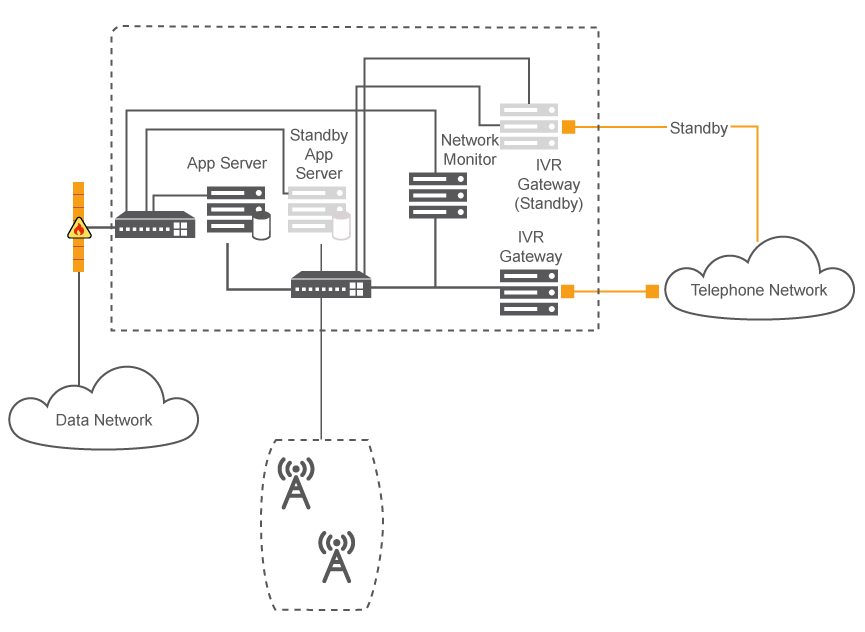VIPER
VIPER is a state-of-the-art Paging Terminal especially designed for the exacting requirements of a high-reliability emergency services system
VIPER is a state-of-the-art Paging Terminal especially designed for the exacting requirements of a high-reliability emergency services system
Essentially VIPER acts as a communications switch, marshaling, queuing and encoding message streams to a large number of devices through a large set of transceiver sites.

There are three versions of VIPER, and a set of plug-ins that extend VIPER functionality. The Viper versions correspond to the size and complexity of the system being managed:
Designed for five nines high-reliability critical networks with tens of thousands of devices and hundreds of base stations.
Viper Enterprise provides a mission-critical Paging Terminal infrastructure for the management of message streams in a wide area simulcast paging network. The Paging Terminal lies at the heart of modern paging systems, and effectively serves as a switch that receives pager message inputs from a diverse variety of streams, encodes the messages into over-the-air signals, and then transmits the message over a wireless frequency network to a group of pager devices. In addition to this fundamental switching functionality, a Paging Terminal also provides comprehensive management, control and audit functionality.
The Viper Enterprise solution is designed to provide 99.999% availability in a large scale mission critical system:
Optional modules and interconnects available with VIPER include:
The Viper Enterprise solution can be easily scaled from tens of thousands of devices to hundreds of thousands. The inherently scalable architecture is easily expandable to meet growing demand. The system is very flexible, and supports industry-standard paging protocols, varying baud rates and a diverse range of interfaces and connections.
The Viper Enterprise PagingTerminal has a network monitoring function, that receives message confirmation signal reports from each base station transmitter, and monitors these reports for quality of service and for confirmation failures. In addition, the Terminal is fully alarmed with an integrated alert monitoring system, including upstream SNMP escalation to other monitors.
The Viper Enterprise system can accept messages from a remote or local entry terminal, and from a wide range of input streams, include CAD systems, PABX systems, nurse call systems, building management systems and product control systems.
The Viper Enterprise system has a large set of interfaces pre-configured into the architecture, including IVR, PABX, HTTP, TAP, SMS Gateway, E-Mail gateway and TNPP.
The Viper Enterprise system incorporates group paging functionality, whereby a set of pagers can be notified with the same message via a single control. Groups can be formed rapidly, to allow for complete flexible control over the dispatch of teams.
When connected to Infostream pagers, VIPER provides OTA management of configuration and software versions, removing the need for costly return to base maintenance.
The Viper system incorporates flexible priority schemes, where priority messages can be sent ahead of lower priority messages (on a “next out” basis) and the system is designed to manage multiple message queues with different priority rules.
The Viper Enterprise solution includes a hot-standby disaster recovery site, that can be automatically failed across, together with fault tolerant clusters at each site to ensure continuous operation.
Viper Enterprise systems have full audit trails of all messages, recording the message, its time and control data, and any confirmatory data regarding message transmission. In mission critical systems that are often regulated with strict KPI performance measures, VIPER provides comprehensive reporting functions on this historical data.
The Viper solution is delivered over a core IP network, and the operator interface is via a web-based browser, enabling easy connection of new or geographically dispersed operators onto the system.
Designed for oil fields, hospitals and mines with hundreds and tens of base stations covering a specific local geographic are or site.
Viper Local provides a high-reliability infrastructure for the management of message streams in a specific site paging network. The solution is designed to provide 99.9% availability and can be configured for different levels of performance and reliability. It has the following features:
Viper Local provides a system that receives a message stream, configures and manages the message stream, and delivers the message stream through connections to a set of simulcast base stations. As part of that process VIPER manages devices, capcodes, groups and priorities within the stream and provides a real-time interface to the operation of the paging network.
Optional modules and interconnects available with VIPER include:
The Viper Local solution can be scaled to support thousands of devices. The system is very flexible, and supports industry standard paging protocols, varying baud rates and a diverse range of interfaces and connections.
The Viper Local PagingTerminal has a network monitoring function, that receives message confirmation signal reports from each base station transmitter, and monitors these reports for quality of service and for confirmation failures.
In addition, the Terminal is fully alarmed with an integrated alert monitoring system, including upstream SNMP escalation to other monitors.
The Viper Local system can accept messages from a remote or local entry terminals, and from a wide range of input streams, include CAD systems, PABX systems, nurse call systems, building management systems and product control systems.
The Viper Local system has a large set of interfaces pre-configured into the architecture, including IVR, PABX, HTTP, TAP, SMS Gateway, E-Mail gateway and TNPP.
The Viper Local system incorporates group paging functionality, whereby a set of pagers can be notified with the same message via a single control. Groups can be formed rapidly, to allow for complete flexible control over the dispatch of teams.
When connected to Infostream pagers, VIPER provides OTA management of configuration and software versions, removing the need for costly return to base maintenance.
The Viper system incorporates flexible priority schemes, where priority messages can be sent ahead of lower priority messages (on a “next out” basis) and the system is designed to manage multiple message queues with different priority rules.
The Viper Local solution can be configured as a fault tolerant clusters to ensure continuous operation.
Viper Local systems have full audit trails of all messages, recording the message, its time and control data, and any confirmatory data regarding message transmission. In mission critical systems that are often regulated with strict KPI performance measures, VIPER provides comprehensive reporting functions on this historical data.
The Viper solution is delivered over a core IP network, and the operator interface is via a web-based browser, enabling easy connection of new or geographically dispersed operators onto the system.
Designed for single base stations use in a single building or factory with tens of devices.
Viper Micro provides a solution for a powerful, flexible single site paging solution that can manage a group of pagers. The solution is designed to provide a reliable environment for the support of local site paging:
Viper Micor provides a system that receives a message stream, configures and manages the message stream, and delivers the message stream through connections to a large set of simulcast base stations. As part of that process VIPER manages devices, capcodes, groups and priorities within the stream and provides a real time interface to the operation of the paging network.
Optional modules and interconnects available with VIPER include:
The Viper Micro solution is designed for a single site installation. It is very flexible, and supports industry-standard paging protocols, varying baud rates and a diverse range of interfaces and connections.
The Viper Micro PagingTerminal is fully alarmed with an integrated alert monitoring system, including upstream SNMP escalation to other monitors.
The Viper Micro system can accept messages from a remote or local entry terminal, and from a wide range of input streams, include CAD systems, PABX systems, nurse call systems, building management systems and product control systems.
The Viper Micro system has a large set of interfaces pre-configured into the architecture, including IVR, PABX, HTTP, TAP, SMS Gateway, E-Mail gateway and TNPP.
The Viper Micro system incorporates group paging functionality, whereby a set of pagers can be notified with the same message via a single control. Groups can be formed rapidly, to allow for complete flexible control over the dispatch of teams.
When connected to Infostream pagers, VIPER provides OTA management of configuration and software versions, removing the need for costly return to base maintenance.
The Viper system incorporates flexible priority schemes, where priority messages can be sent ahead of lower priority messages (on a “next out” basis) and the system is designed to manage multiple message queues with different priority rules.
The Viper solution is delivered over a core IP network, and the operator interface is via a web-based browser, enabling easy connection of new operators.
| Parameter | Value |
| Unit Sizing | 115 x 115 x 35 mm, 505g |
| Power | +5V @ 1.8 amp |
| Operating Temperature | -20 to 70 degrees C |
| Operating Humidity | 0% – 90% relative humidity, non-condensing |
| Certifications | CE, FCC |
| Connections | Integrated r6040 10/100 Mbps LAN |
In addition to the base versions, there are a number of plug-ins available that extend Viper functionality in the areas of:

 Pagers
Pagers This site uses cookies. By continuing to browse the site, you are agreeing to our use of cookies.
Accept settingsHide notification onlySettingsWe may request cookies to be set on your device. We use cookies to let us know when you visit our websites, how you interact with us, to enrich your user experience, and to customize your relationship with our website.
Click on the different category headings to find out more. You can also change some of your preferences. Note that blocking some types of cookies may impact your experience on our websites and the services we are able to offer.
These cookies are strictly necessary to provide you with services available through our website and to use some of its features.
Because these cookies are strictly necessary to deliver the website, refuseing them will have impact how our site functions. You always can block or delete cookies by changing your browser settings and force blocking all cookies on this website. But this will always prompt you to accept/refuse cookies when revisiting our site.
We fully respect if you want to refuse cookies but to avoid asking you again and again kindly allow us to store a cookie for that. You are free to opt out any time or opt in for other cookies to get a better experience. If you refuse cookies we will remove all set cookies in our domain.
We provide you with a list of stored cookies on your computer in our domain so you can check what we stored. Due to security reasons we are not able to show or modify cookies from other domains. You can check these in your browser security settings.
We also use different external services like Google Webfonts, Google Maps, and external Video providers. Since these providers may collect personal data like your IP address we allow you to block them here. Please be aware that this might heavily reduce the functionality and appearance of our site. Changes will take effect once you reload the page.
Google Webfont Settings:
Google Map Settings:
Google reCaptcha Settings:
Vimeo and Youtube video embeds:
You can read about our cookies and privacy settings in detail on our Privacy Policy Page.
Privacy Policy